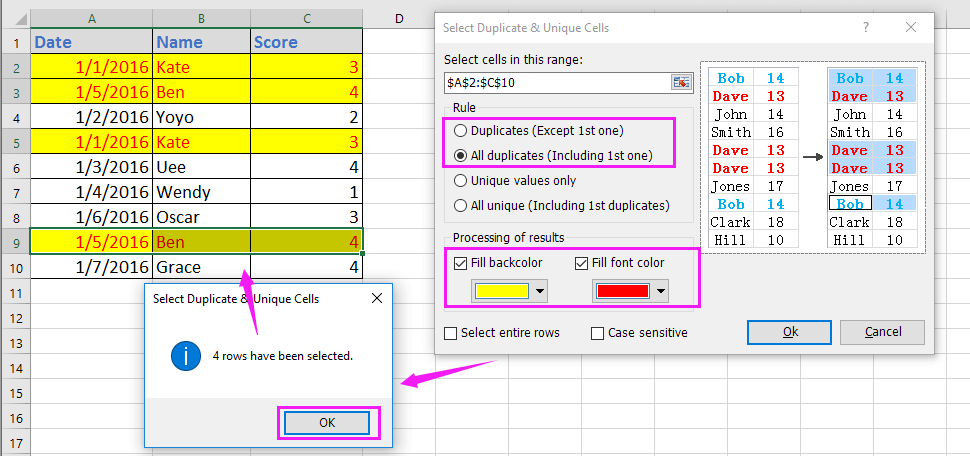Find Duplicate Names in Two Excel Sheets Easily

Efficiently managing and analyzing data across multiple spreadsheets is a common task in many workplaces, particularly where large datasets are involved. One of the typical challenges that arise is the identification of duplicate entries across different Excel sheets. Whether you are reconciling lists, merging databases, or simply cleaning up data, the ability to find duplicate names can save time and reduce errors.
The Importance of Identifying Duplicates

Before we delve into the methods, let's consider why detecting duplicates in Excel is crucial:
- Data Integrity: Ensuring data accuracy by removing or reconciling duplicate entries helps maintain a single, accurate dataset.
- Efficiency in Analysis: Duplicate entries can skew results and make analysis less effective. Identifying them allows for cleaner data for analysis.
- Database Management: For database management, removing duplicates can help optimize storage, performance, and operations.
Methods to Find Duplicate Names

Here are several strategies you can employ to locate duplicates between two Excel sheets:
Using VLOOKUP Function

The VLOOKUP function is a straightforward approach if you're looking to match a list of names against another sheet.
=VLOOKUP(A2, Sheet2!A:A, 1, FALSE)
Enter this formula in cell B2 of the first sheet, assuming your names start from A2. The formula looks for A2 in the same column of Sheet2, and if found, it will return the matched value.
🔍 Note: Ensure the ranges in VLOOKUP are consistent across sheets, and remember, VLOOKUP has some limitations when searching for exact matches if there are duplicate values in the lookup column.
Conditional Formatting for Visual Inspection

For a quicker, visual method:
- Select the range where you want to highlight duplicates on both sheets.
- Go to 'Home' > 'Conditional Formatting' > 'New Rule'.
- Choose 'Use a formula to determine which cells to format'.
- Enter the formula:
=COUNTIF(Sheet1!$A$2:$A$100, A2)>1. - Format the duplicates with a distinct color for easy identification.
This method will not find duplicates across sheets directly but will help in identifying duplicates within one sheet, which can then be matched manually or through further Excel functions.
Using Power Query

Power Query, a powerful data transformation tool in Excel, allows for more complex merging:
- Open Power Query from the 'Data' tab > 'From Other Sources' > 'From Microsoft Query'.
- Import both sheets into the Power Query Editor.
- Use the 'Merge Queries' option to join the two datasets on the column containing names.
- Select 'Full Outer' join type and click 'OK'.
- Filter the results to show only the rows where both keys match.
⚡ Note: Power Query can handle large datasets efficiently, making it suitable for extensive data operations. However, it might require some initial setup and familiarity with its interface.
Using Advanced Filter

This method involves copying data and then filtering:
- Select all data from one sheet.
- Go to 'Data' > 'Advanced'.
- In the 'Advanced Filter' dialog, select 'Copy to another location'.
- Enter the range you want to filter from the other sheet, check 'Unique records only', and choose where to place the filtered list.
💡 Note: The Advanced Filter method is a manual process and might not update dynamically. However, it can be particularly useful for one-time operations.
Practical Tips for Finding Duplicates

- Consistency: Ensure the format and spelling of names are consistent across sheets.
- Check for Variations: Look out for variations like nicknames, middle names, or initials.
- Sorting: Sorting your data before applying any of the above methods can help in visually identifying duplicates.
Detecting and managing duplicates in Excel sheets enhances data accuracy and analysis. While there are several methods available, the choice depends on the size of the dataset, the user's familiarity with Excel functions, and the complexity of the data. For straightforward operations, VLOOKUP or Conditional Formatting might suffice, whereas Power Query provides more advanced capabilities for extensive data management.
Can I use Excel’s VLOOKUP to match partial names?

+
VLOOKUP by default matches whole values. For partial matches, you can use wildcards or concatenate parts of names to create a full match.
What if the names are in different formats or columns on each sheet?

+
You might need to standardize the format before using these methods. For complex scenarios, Power Query offers more flexibility in data transformation.
Is there a way to highlight duplicates automatically in both sheets?

+
Using Conditional Formatting, you can highlight duplicates within one sheet, but for real-time dynamic highlighting across sheets, Power Query or VBA scripting might be necessary.



